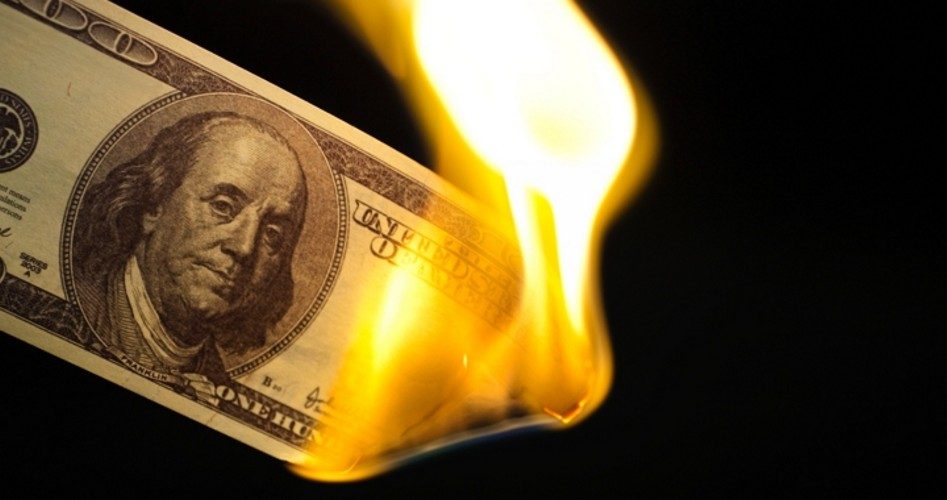
The bad news is nothing lasts forever. The good news is nothing lasts forever — J. Cole
In a little less than six weeks, the current U.S. economic expansion will have lasted seven years. Registering an average annual growth rate of barely over two percent since 2009, economic growth in the post-Great Recession era has been, to say the least, unimpressive. In fact, the economy grew at just a .5 percent annual pace in the first quarter of 2016, its lowest increase in two years.
However, what little remaining growth the economy may have left is threatened by storm clouds on the horizon, as countries across the globe are selling off treasury instruments in record numbers. In January, $57.2 billion of treasury instruments were sold, up from $48 billion in December. It’s not just those two months, either. Central banks around the world sold a record $225 billion of U.S. debt in 2015, including a stunning $187 billion from China alone.
World-wide treasury liquidations tend to occur during or very close to recessions. It’s no coincidence: The countries in question need the cash.
A massive treasuries sell-off happened in 1978, less than two years before the start of the infamous “double dip” recession of the early 1980s. A lesser-scale variation happened just after the Dot Com recession of the early 2000s, and yet another occurred during the latter part of the recent Great Recession. It’s happening again today.
Does the liquidation of treasuries also reflect a loss of confidence in the U.S. economy? It’s certainly a possibility. After all, the Federal Reserve has quadrupled its balance sheet and added over $3 trillion to the U.S. money supply in a short eight years.
Due to the monetary policy of the Federal Reserve over the past quarter century, the business cycle has been dramatically and irretrievably altered. How so? Before we answer that question, let’s define what ‘business cycle’ means. Per Investopedia:
The business cycle is the fluctuation in economic activity that an economy experiences over a period of time. A business cycle is basically defined in terms of periods of expansion or recession.
‘Expansion’ is a synonym for growth, and despite the fact that the current recovery has been the most torpid on record, the economy has managed to avoid a significant downturn since the end of the Great Recession in June, 2009. Although present-day economists draw lines with varying degrees of subjectivity, the time-tested litmus test for a recession is two consecutive quarters of negative growth. So far, that’s been avoided — if only by a whisker.
Seeing alarming data that indicated a pending recession was around the corner, the Federal Reserve quickly lowered interest rates starting in September of 2007. As a result, the Prime Rate fell from 8.25 percent to 3.25 percent in the span of just nine quarters, remaining at that level for a record seven years.
Low interest rates can help spur borrowing, as consumers and businesses finance purchases more cheaply. However, the economy literally became dependent upon low rates, eking out unimpressive GDP growth even with the stimulus of low borrowing costs. The Fed couldn’t raise rates, for fear of derailing the fledgling recovery, and yet low rates were barely moving the dial with respect to stoking a stronger economy. The United States became trapped in a Japan-style “lost decade” of its own, one in which it remains mired in today.
Aggressive monetary policy and the usage of Keynesian economic tactics have had a dramatic impact on the business cycle. Sheldon Richman of The American Conservative had this to say about Keynesian economics:
The trouble with Keynesianism is not only that its focus on macroeconomic aggregates to the neglect of microeconomic human action on the ground “conceal[s] the most fundamental mechanisms of change,” as F.A. Hayek noted. It is also that Keynesianism sanctions politicians in doing what they wish to do already: spend the people’s money, debauch the currency, and engineer society in their own image — all in order to stay in power.
Between 1854 and 1919, the average economic contraction lasted 21.6 months, and from 1919 to 1945, 18.2 months. Since then, largely as the result of Federal Reserve intervention, downturns have lasted just 11.1 months. Meanwhile, periods of expansion have more than doubled in length.
Is that a good thing? In the short term, perhaps so. However, stimulus has had the effect of massively increasing the money supply, which ultimately leads to a debasement of the dollar as well as creating kindling for rampant inflation down the road.
Despite the notion that the United States can simply print money to pay its debts in perpetuity, a rational investor has to believe that the ink will eventually run dry in the Fed’s printing presses. And the Chinese are anything but irrational, so if they feel the U.S. economy is in serious trouble, they won’t hesitate to dump their supply of U.S. treasuries.
Could the greatest sell-off of U.S. treasuries in fifteen years mean a global recession is right around the corner? If recent history is a guide, the next big recession could be closer than many people think. With the money supply at a record high and interest rates already at bare minimum, the Fed has far fewer tools at their disposal to stimulate the economy.




